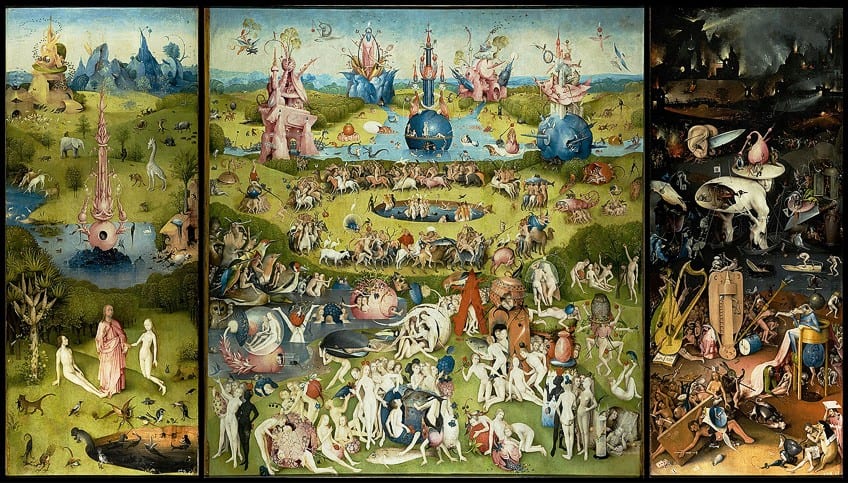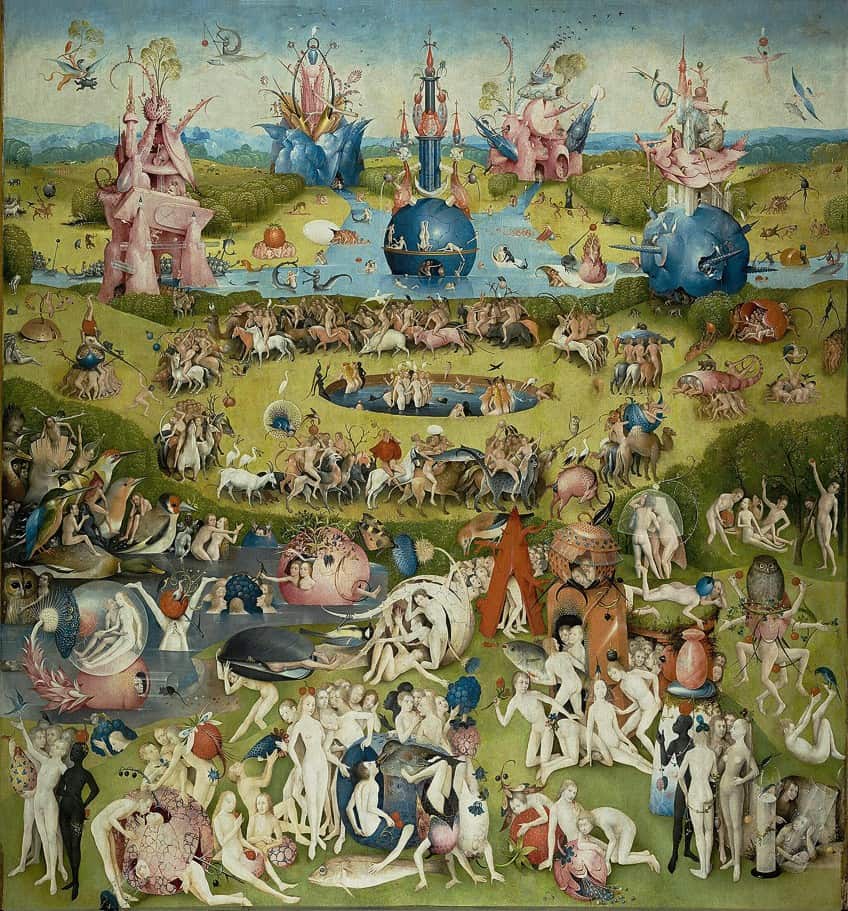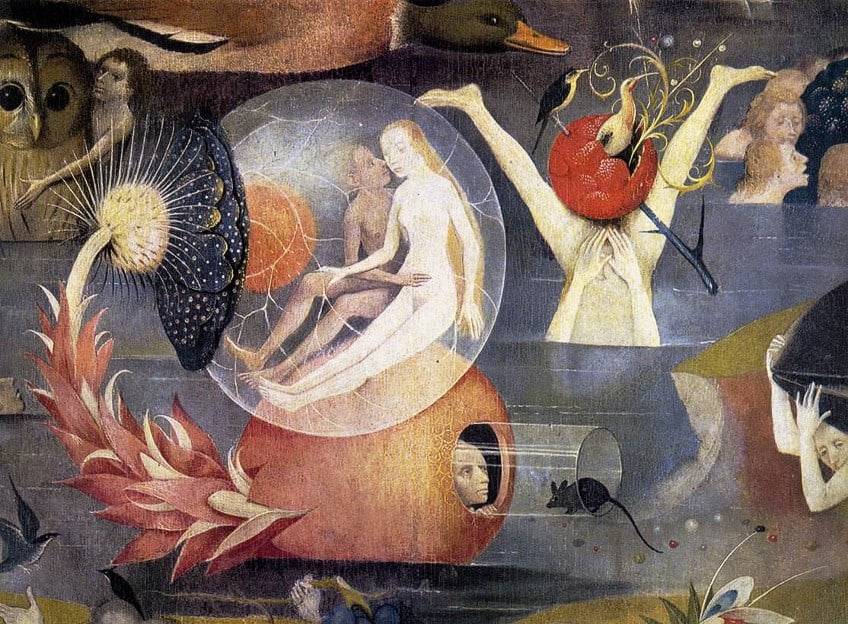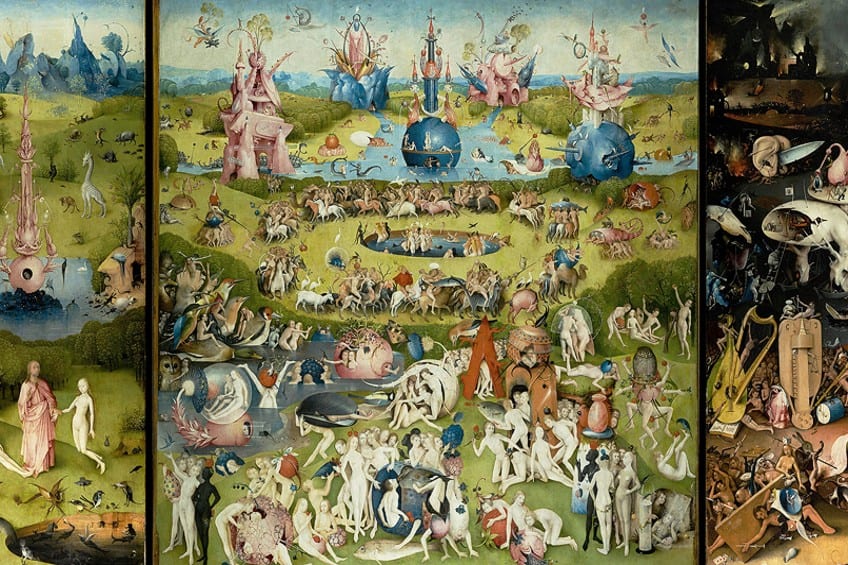“The Garden of Earthly Delights” by Hieronymus Bosch – A Look
The Garden of Earthly Delights by Hieronymous Bosch is an enigmatic triptych painting that ultimately raises more questions than it answers. For one thing, not much is known about Hieronymus Bosch, the artist who created this mysterious masterpiece. The Garden of Earthly Delights meaning is also unclear, but that has not stopped countless individuals from trying to decode its visual symbolism. The Garden of Earthly Delights analysis could reveal many little details that might give us a clue as to what Bosch’s triptych was all about, so join us as we break down this strange and famous artwork!
What Is The Garden of Earthly Delights by Hieronymus Bosch All About?
| Artist | Hieronymus Bosch (c. 1450 – 1516) |
| Date Completed | c. 1490 |
| Medium | Oil on oak panel triptych |
| Dimensions (cm) | 205 x 385 |
| Location | Museo del Prado, Madrid, Spain |
Because there is so little information on Bosch, the artist’s intentions, or life, there have been numerous interpretations of Bosch’s triptych, ranging from a warning about earthly indulgence to a depiction of complete sexual bliss. The intricate symbolism of the central panel, in particular, has given rise to an array of varying interpretations over time. What we do know about other triptychs from this period, including Bosch’s triptychs, is that they are meant to be read and interpreted sequentially, from left to right. Before we get into The Garden of Earthly Delights’ analysis, though, let’s find out more about Bosch, the artist.
Hieronymus Bosch the Artist
| Artist Name | Hieronymus Bosch |
| Nationality | Dutch |
| Date of Birth | c. 1450 |
| Date of Death | 9 August 1516 |
| Place of Birth | s-Hertogenbosch, Duchy of Brabant, Burgundian Netherlands |
Not much is really known about Hieronymus Bosch’s life or the inspiration behind the iconography of his work. His birth date, educational background, and patrons are even unidentified. There is no record of Bosch’s motivations or indication of what attracted him to such a unique style of artistic expression. Art historians have been trying for centuries to shed light on this issue, and their results have been fragmentary at best. Historians have discussed Bosch’s iconography more than any other artist from the Netherlands.
Bosch’s triptychs tend to be viewed as enigmatic, leading many to suggest that their meaning involves esoteric knowledge that has since been lost to our history.

The Garden of Earthly Delights by Hieronymous Bosch was made during an era of discovery and adventure when legends and treasures from the New World inspired the poets, artists, and authors of that time. Despite the artwork’s various otherworldly and bizarre creatures, Bosch’s illustrations and cultural references still resonated with the elite aristocratic and humanist audience.
The Garden of Earthly Delights Analysis and Description
Bosch’s triptych comprised a central panel and two side panels that were able to close, revealing a painting on the exterior panels. The outside panels are believed to portray the world’s creation, with flora spreading over the still-pristine planet. God appears as a little figure in the top left corner of the exterior panel, donning a crown resembling a papal tiara. Bosch depicts God as a fatherly figure seated with a Bible resting on his lap, passively forming the Earth by means of divine command.
The Earth is enclosed in a translucent sphere, recalling the traditional representation of the world as a crystal globe held by God.

The planet is depicted as suspended in space, which is represented as an impenetrable blackness with God as the sole occupant. Despite its abundance of flora, the world depicted on the exterior lacks any animal or human life, perhaps implying that it depicts the Old Testament’s Third Day of creation. The exterior panels occupy a distinct place in the artwork’s overall chronological storyline.
They depict an unpopulated planet made up entirely of rocks and vegetation, which contrasts strongly with the central panel on the inside, which depicts a paradise filled with lust-filled mankind.
The Interior of Bosch’s Triptych
Scholars have suggested that Bosch the artist employed the exterior panels to provide a Biblical context for the work’s inner elements, and the artwork on the exterior is often read as having occurred significantly earlier than those portrayed in the artwork’s interior. The inner central panel is bordered by imagery that is both heavenly and hellish.
The events portrayed in Bosch’s triptych are believed to be in chronological sequence, with Eden on the left, the Garden of Earthly Delights in the middle, and Hell portrayed on the right.
The left side depicts God as the creator of mankind, while the right depicts the repercussions of humanity’s inability to obey his will. In contrast to Bosch’s other two full triptychs, God is missing from the central panel in this work. Instead, this panel depicts nude humans engaging in different pleasure-seeking behaviors with evident free will. According to certain interpretations of the piece, the right-hand panel depicts God’s wrath in a hellscape.
The Left Panel
The left panel of Bosch’s triptych portrays a scene from paradise, usually thought of as the moment God gifts Eve to Adam in the Garden of Eden. The scene depicts Adam waking up from a deep slumber to discover God grasping Eve’s wrist and blessing them. God seems younger than in the exterior panels, with blue eyes and golden locks of hair. Eve attempts to avoid Adam’s gaze while at the same time seductively displaying her body to Adam, whose expression is one of amazement.
The surrounding environment is densely packed with hut-shaped formations, some of which have been constructed of stone and others of which are at least partly organic. Rabbits, representing fertility, frolic in the grass behind Eve, while a dragon tree close by is said to symbolize perpetual life.

The scenery in the background includes a monkey riding on the back of an elephant, a giraffe, and a lion who slaughtered and is preparing to eat his prey, all of which would have seemed unusual and exotic to the Europeans of that time. In the foreground, birds and flying animals arise from an immense hole in the earth, some life-like, others imaginary. An individual in a short-sleeved hooded jacket with a duck’s beak stands behind a fish, holding a book open as if reading it intently. A cat is holding a little lizard-like creature in its jaws to the left.
While the creatures that appear in the front are fantastical creatures, many of the animals in the middle and background have been taken from the travel literature of the period, suggesting that Bosch was trying to appeal to a humanistic and aristocratic audience.
The Central Panel
In the central panel, the garden is swarming with naked people, as well as various animals, plants, and fruits. The environment is not the paradise depicted on the panel on the left, but it is also not set on Earth. Mystical animals mix with the real; the fruit seems engorged to enormous proportions. The individuals in the painting are involved in a variety of sexual activities, both as individuals and in groups. Several of the various figures seem to be experiencing sensory delights, while others frolic unselfconsciously in the waters, and yet more play in fields with an assortment of animals, evidently in harmony with nature.
A big blue globe like a fruit pod arises in the center of a lake in the distance. An individual with his right hand near his partner’s sexual organs is visible through its round window, while another person with bare buttocks hovers nearby. The central panel’s sexuality could either be seen as an allegorical representation of spiritual transformation or as a corrupting playground.
The foreground lacks perspectival order, instead consisting of a collection of little motifs that abandon proportion and earthly logic. Giant ducks play with little people beneath a canopy of giant fruit; fish move around on land while birds live in the sea; an affectionate couple wrapped in a fluidic bubble; and an individual within a red fruit looking at a mouse in a glass cylinder are among the visuals presented to the observer by Bosch. Swimmers of both sexes can be seen in the foreground and distant pools. The sexes are mainly segregated in the middle circular pool, featuring multiple females ornamented with fruit and peacocks.

A procession of nude men riding donkeys, horses, unicorns, camels, and other exotic or magical beasts surrounds the females. Several males do dance while riding, supposedly to grab the girls’ attention, emphasizing the desire felt by the two genders as groups. Both men and women can be seen frolicking with abandon in the two outer springs. Birds populate the waters around them, and they are surrounded by colossal eggshells and fruit pods, with both animals and humans gorging themselves on cherries and strawberries.
The lack of children and the elderly adds to the depiction of a life lived without consequence. Four groups of creatures of all types may be seen flying in the background above the hybrid stone structures.
On the far left, a man is riding a solar eagle lion. The person carries a three-branched tree of life on which a symbolic bird of death is perched. A knight with the tail of a dolphin glides on a winged fish to the right. The knight’s tail coils back and touches his head, alluding to the snake biting its own tail, a traditional symbol of immortality. A winged boy flies skyward to the right, with a falcon on his back, and a fish in his hands.
The Right Panel
The right panel depicts Hell, a place that is depicted in a number of Bosch’s works. Bosch portrays a world in which humanity has fallen victim to temptations that result in depravity and damnation for eternity. This last panel’s tone is starkly different from those that came before it. The setting takes place at night, and the natural beauty that illuminated the previous panels is no longer present. In contrast to the warmth depicted in the central panel, the right panel has a cold quality – rendered by icy colorization and frozen waterways – and depicts a scene that has changed from paradise to a place of horrific torture and vengeance. The observer becomes witness to towns on fire, torture chambers, demons in the middle ground; and deformed creatures eating human flesh in the foreground .
The nudity of humans has lost all sexiness, and many people now try to conceal their genitals with their hands, embarrassed by their vulnerability.
Large explosions in the back cast light through the city gates and into the water in the foreground. The light reveals a road full of fleeing humans, while armies of tormentors are ready to burn down a nearby settlement. A rabbit runs away with a corpse, as the victims above are flung into the flames of a burning lantern. Various kinds of distressed people dominate the foreground. Some are seen throwing up or excreting, while others are hung by lute and harp in a musical metaphor, emphasizing the difference between pleasure and suffering. A choir sings from an arrangement engraved on a pair of buttocks as a member of the “Musicians’ Hell” ensemble.

The “Tree-Man” serves as this scene’s focal point, with his hollow torso held up by what may be deformed arms or decaying tree trunks. His head is propped up by a disk filled with monsters and victims walking around a massive set of bagpipes resembling the human scrotum. The torso is made of cracked eggshell, and its supporting trunk features thorn-like branches that penetrate the frail flesh. A gray individual in a hood descends a ladder inside the tree-man’s interior hollow, where naked men sit in a tavern-like environment. The tree-man looks past the observer with a face that is displaying an expression that is a combination of wistfulness and despondency.
Many of the details in the panel are based on older depictions of hell. Bosch, the artist, is unique in that he presents hell as a realistic environment with numerous elements from everyday human existence, rather than a completely fantastical environment.
Animals are depicted punishing humans by subjecting them to horrific tortures that could symbolize the seven deadly sins, with the torture matching the sin. This panel’s centerpiece is a massive bird-headed creature sitting on what appears to be a toilet, excreting human corpses into the translucent chamber pot on which he sits. The creature is also known as the “Prince of Hell,” a term derived from the pot he bears on his head, which could suggest a debased crown. A female’s face is mirrored on the bottom of a demon. A group of nude people around a collapsed gambling table are being butchered with knives and swords to the left, close to a hare-headed monster. A knight is pulled down and gobbled alive by a group of wolves to the right of the tree-man, exhibiting even more horrible brutality.
The Garden of Earthly Delights Meaning
Some saw lust and sexuality as signs of the fall from grace of humanity throughout the Middle Ages. Some viewers believe that this sin is reflected in the left-hand panel by Adam’s passionate glance toward Eve and that the central panel was meant as an advisory tale to the observer to steer clear of a life of wicked earthly pleasures. Based on this perspective, the punishment for such transgressions is depicted in the triptych’s last panel. An individual has been approached by a pig sporting a nun’s veil in the bottom corner. The pig appears to be persuading the man to fill out legal forms.
The massive musical instruments and choir singers in the left foreground of the last panel are also supposed to represent lust. Musical instruments were often linked with sensual overtones in works of art of the time, and passion was sometimes referred to as “music of the flesh” in moralizing literature.
There has also been speculation that Bosch’s use of music here is a protest to wandering minstrels, who were viewed as purveyors of vulgar songs. His painting is generally interpreted as a cautionary tale against desire, with the middle panel representing the transience of earthly pleasure. Bosch demonstrates how sin entered the world with the creation of Eve, how fleshly desires spread across the entire planet, supporting all of the Deadly Sins, and how this inexorably leads to Hell.

Proponents of this theory point out that moral philosophers of Bosch’s day felt that it was the seduction of women – inevitably Eve’s – that led humanity into a life of debauchery and immorality. This could clarify why women in the central panel are such crucial players in causing the Fall. Femininity’s power and influence at that time were often demonstrated at the time by depicting a female encircled by a group of men.
The sumptuousness of Bosch’s portrayal may have been meant to represent a false paradise abounding with fleeting beauty since the medieval mentality was inherently distrustful of material beauty in any shape or form.
The Legacy and Influence of Bosch’s Triptych
Bosch’s impact has not extended as extensively as that of other prominent artists of his age since he was such a distinctive and imaginative artist. However, there are still many painters who have incorporated aspects of this picture in their own works. Pieter Bruegel the Elder, in particular, acknowledged Bosch as a major influence, and integrated many aspects from the inner right panel into some of his most famous artworks. While Giuseppe Arcimboldo, an Italian court artist, did not paint Hellscapes, he did produce a body of unusual and “fantastical” vegetable portraits – typically heads of people comprised of roots, plants, and various other organic materials.
Bosch’s art saw a popular revival at the start of the 20th century. The infatuation of the early surrealists with dreamscapes, the independent functioning of the imaginative mind, and a free-flowing relationship with the unconscious rekindled interest in his paintings.

Salvador Dalí and Joan Miró, in particular, were influenced by Bosch’s artistic vision. In 1924, when André Breton published his first Surrealist Manifesto, he included only Georges Seurat, Gustave Moreau, and Uccello as historical antecedents. The Surrealist movement, though, promptly rediscovered the works of people like Bruegel and Bosch, who immediately became influential among Surrealist artists.
With that, we have come to the end of this article on The Garden of Earthly Delights by Hieronymus Bosch. The central panel’s swarms of naked, frolicking people make it exceedingly improbable that the work was intended as a religious altarpiece. Though the individuals involved do not engage in explicit sexual actions, the hallucinatory setting would certainly have been out of place in a church or other religious building. Instead, the painting was most likely commissioned by a private client. Some historians have referred to Bosch’s triptych as “serving as a kind of Renaissance home theater for wealthy clients”. Because the interpretations of the panels are interrelated, the triptych probably had been designed to be interpreted from left to right. God introduces Eve to Adam in the left panel, while the torment of damnation is displayed in the right panel. The painting received its title from the central panel, which is the most well-known panel. This garden depicts the odd and bizarre temptations that exist on Earth. Reading from left to right, we can see the manner in which man was formed, lived, and finally failed as a result of his own actions.
Frequently Asked Questions
What Was The Garden of Earthly Delights Created For?
While the original reason for the painting’s production remains unknown, it can most likely be deduced that it was not meant to serve as a church altarpiece. It was most probably created for a wealthy private patron, although there is no record of who the original client was. In fact, even the name of the painting was only given in the modern era, and we don’t know what the artist actually titled it. A large part of the reason this painting is regarded as so enigmatic is because of all the unanswered questions surrounding it to this day!
How Is The Garden of Earthly Delights Meant to Be Viewed?
Bosch’s triptych consists of three panels, each with its own scene. First off, the triptych must be viewed closed, as the exterior has its own image. Then, once opened, it must be read from left to right.
Jordan Anthony is a Cape Town-based film photographer, curator, and arts writer. She holds a Bachelor of Art in Fine Arts from the University of the Witwatersrand, Johannesburg, where she explored themes like healing, identity, dreams, and intuitive creation in her Contemporary art practice. Jordan has collaborated with various local art institutions, including the KZNSA Gallery in Durban, the Turbine Art Fair, and the Wits Art Museum. Her photography focuses on abstract color manipulations, portraiture, candid shots, and urban landscapes. She’s intrigued by philosophy, memory, and esotericism, drawing inspiration from Surrealism, Fluxus, and ancient civilizations, as well as childhood influences and found objects. Jordan is working for artfilemagazine since 2022 and writes blog posts about art history and photography.
Learn more about Jordan Anthony and about us.
Cite this Article
Jordan, Anthony, ““The Garden of Earthly Delights” by Hieronymus Bosch – A Look.” artfilemagazine – Your Online Art Source. October 19, 2023. URL: https://artfilemagazine.com/the-garden-of-earthly-delights-by-hieronymus-bosch/
Anthony, J. (2023, 19 October). “The Garden of Earthly Delights” by Hieronymus Bosch – A Look. artfilemagazine – Your Online Art Source. https://artfilemagazine.com/the-garden-of-earthly-delights-by-hieronymus-bosch/
Anthony, Jordan. ““The Garden of Earthly Delights” by Hieronymus Bosch – A Look.” artfilemagazine – Your Online Art Source, October 19, 2023. https://artfilemagazine.com/the-garden-of-earthly-delights-by-hieronymus-bosch/.



